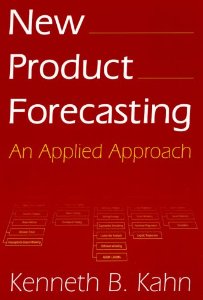How do you build a forecast when you have no historical data?
This is a recurring challenge for businesses that update their product offerings, and a recurring question in online forecasting discussion groups (e.g. this one on LinkedIn).
The bad news is that you probably can't expect to achieve highly accurate new product forecasts. It may be wiser to expect highly inaccurate new product forecasts, and manage your operations accordingly. If you do decide to bet your company on the forecasted success of a new product, just don't act surprised when you lose the bet.
 The good news is that there are plenty of ideas on how to address the new product forecasting challenge. One place to start is Ken Kahn's book, New Product Forecasting - An Applied Approach.
The good news is that there are plenty of ideas on how to address the new product forecasting challenge. One place to start is Ken Kahn's book, New Product Forecasting - An Applied Approach.
Ken identifies the various types of new product forecasting situations, such as product improvements, line extensions, new uses/markets, and entirely new to the world products. He provides a "toolbox" approach to illustrate how new product forecasts can be generated in this variety of situations.
An important point, made early in the book, is to accept that error will exist, but work to develop the most meaningful forecast possible coupled with an understanding of contingencies. When you admit that a high degree of error is likely, you can make your financial and operational plans flexible enough to accomodate the uncertainty. You can get yourself in trouble, at the other extreme, when you doggedly lock all your plans on a forecast that may not come true.
[Sidenote: This book's Foreword is written by Martin Joseph and Alec Finney, formerly of AstraZeneca, and now of Rivershill Consultancy. Martin and Alec contributed a recent Foresight article on process control methods in forecasting (Fall 2103 issue), and will deliver this quarter's SAS / Foresight Webinar on "The Forecasting Mantra" (February 20, 11am ET).]
Another source of useful discussion is the Winter 2012-13 Journal of Business Forecasting, a special issue with several articles on new product forecasting:
- Patrick Bower, "Forecasting New Products in Consumer Goods"
- Michael Kelleher, "The Art and Science of New Product Forecasting"
- Jonathon Karelse, "New Product Planning in the Replacement Tire Industry"
- Larry Lapide, "Downstream Demand Signals for New Products"
My own contribution to the special issue is an article on "Worst Practices in New Product Forecasting." We'll discuss some of these, as well as a better practice -- new product forecasting using structured analogies -- over the next few blog installments.
